Ford Escape
Front Brake Pads Replacement Guide
How to change the front disc brake pads
on a 3rd generation 2013-2016 Ford Escape SUV with photo illustrated steps.
By Paul B. Michaels Author & Photographer Auto Mechanic Since 1989 |
||
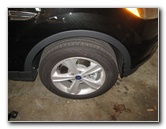 2015 Escape Front Wheel |
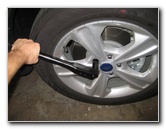 Loosen 5 Lug Nuts |
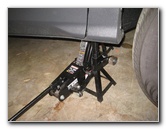 Raise Front of Vehicle |
| This
automotive maintenance tutorial was specifically written to assist
owners of the 3rd generation (2013, 2014, 2015, 2016 and possibly also
the updated 2017 model year) Ford Escape SUV in changing the front
disc brake pads and lubricating the caliper slider pins. Owners of other Ford or Lincoln vehicles such as the Focus, Fusion, C-Max, Mustang, Fiesta, Transit Connect, Edge, Flex, Explorer, Expedition, Taurus, F-150, EcoSport, MKC, MKZ, MKS, MKX, MKT and the Navigator may also find these DIY instructions to be helpful. The items needed to complete this procedure include a lug nut wrench, a floor jack, two jack stands, a flathead screwdriver, a 7mm hex head socket with a ratcheting wrench or a 7mm Allen Key wrench, a "C" or "F" clamp and a tube of high temperature synthetic brake parts lubricant grease. |
||
|
|
||
Please verify the correct replacement part numbers for your Ford Escape. The compatible parts vary depending on whether your SUV has 2WD (two wheel drive), 4WD (four wheel drive / 4 wheel drive), the model year and/or the trim level. A few compatible sets of replacement front brake pads with their replacement part numbers are as follows: Centric Ceramic 105.16450, Carquest Wearever Gold Ceramic GNAD1044, Wagner ThermoQuiet QC1563, ProAct Ultra Premium Ceramic ACT1044, Akebono ProAct ACT1044, ProStop Platinum PGD1645C, Power Stop 17-1645 Z17 Evolution, Bendix D1044, TRW TPC1645, Hawk Performance HB519F.682 and TRW TPC1645. |
||
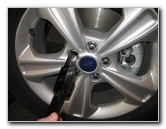 Spin Off 5 Lug Nuts |
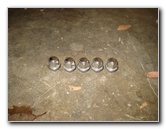 Five Lug Nuts Removed |
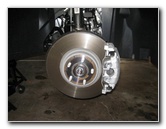 Rotor, Caliper, Bracket |
| The first few steps
are to park the SUV on a level surface, turn off the engine and engage the
emergency / parking brake. Chock both sides of the rear wheels to prevent the car from moving while you are replacing the pads. Slightly loosen the five lug nuts on the front wheel by turning them counterclockwise. Just break them free by a 1/4 to 1/2 turn. Carefully raise the front of the SUV and securely support it with at least two jack stands. I prefer to work on one side of the car at a time to keep three wheels on the ground for extra safety. Spin off the 5 lug nuts in the counterclockwise direction and set them aside in a safe place. Carefully pull off the front wheel to reveal the rotor, bracket, caliper and the front suspension. |
||
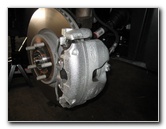 Front Brake Caliper |
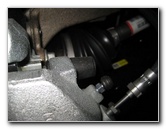 Plastic Caliper Bolt Cap |
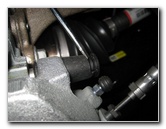 Pry Out Plastic Bolt Cover |
| The front brake
caliper is held in place to the bracket by two bolts located on the back
side of the caliper. Gently pry off the round black plastic dust cover from the two caliper bolt housings with a small flathead screwdriver. |
||
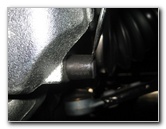 Remove Lower Bolt Cap |
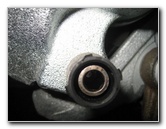 7mm Hex Caliper Bolt |
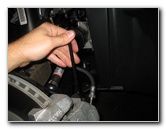 Loosen Clockwise |
| Set the two dust
caps aside in a safe place. Loosen the upper caliper bolt by turning it clockwise (as seen from the outside of the vehicle) with the 7mm hex head socket and ratcheting wrench or a 7mm Allen Key wrench. |
||
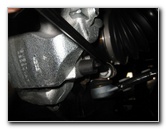 Loosen Lower Bolt |
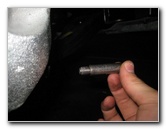 Combo Bolt / Slider Pin |
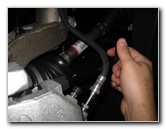 Spin Out Bottom Bolt |
| Loosen the lower
caliper bolt by turning it clockwise (as seen from the outside of the car)
with the 7mm Allen Key wrench. Continue spinning out the caliper bolts which also act as the caliper slider pins or "guide pins". Set the two combination caliper bolts / slider pins aside in a safe place. |
||
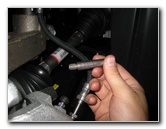 Top Bolt / Slider Removed |
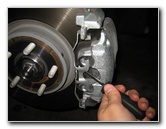 Gently Pry Off Spring Clip |
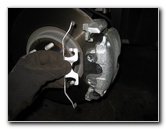 Metal Clip Removed |
| Gently pry off the
metal retaining spring clip on the outer edge of the caliper with a flathead
screwdriver. Set the spring clip aside in a safe place. |
||
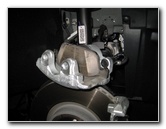 Rest Caliper On Suspension |
 Remove Old Outer Pad |
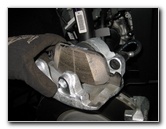 Pull Out Old Inner Pad |
| Carefully rest the
caliper on the suspension or suspend it from the spring with a bungee cord. Pull the old outer brake pad out of the bracket and set it aside for future use. |
||
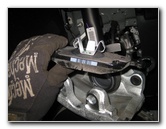 Metal Prongs - Inner Pad |
 Attach "C" Clamp To Piston |
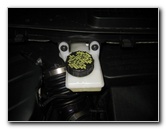 Brake Fluid Reservoir |
| The inner brake pad
is held in place to the caliper by three metal prongs attached to the
piston. Pull the old inner brake pad out of the caliper piston and discard it. Attach the "C" or "F" clamp to the caliper and use the back of the old outer brake pad to evenly distribute the pressure across the piston. Move to the right rear area of the engine bay and twist off the black plastic brake fluid reservoir cap in the counterclockwise direction. |
||
|
|
||
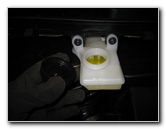 Twist Off Brake Fluid Cap |
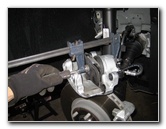 Compress Caliper Piston |
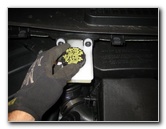
|
| Removing the
reservoir cap will allow the brake fluid to more easily travel backwards
through the lines when you compress the caliper piston. Slowly turn the "C" or "F" clamp handle in the clockwise direction to compress back the piston. Repeatedly check the brake fluid level in the reservoir while you are compressing the piston to make sure that it doesn't over flow. Clean up any spilled brake fluid immediately and rinse the area with plenty of water. Brake fluid can easily damage painted surfaces. Continue pushing back the caliper piston until it is just about flush with the rubber dust boot surrounding it. Try to avoid pinching or otherwise damaging the rubber dust boot surrounding the caliper piston. Replace the brake fluid reservoir cap as soon as possible since brake fluid is hygroscopic (readily absorbs moisture from the air). Twist on the cap in the clockwise direction. Thoroughly clean off the brake rotor, caliper bracket, lug nut studs and the brake caliper assembly with brake parts cleaner spray. Do not use compressed air or blow with your mouth to clean off the brake parts since breathing in brake dust can be harmful to your health. Brake dust can be carcinogenic (cancer causing) if inhaled.
To remove the existing rotors and install new ones, remove the two bolts on the rear of the caliper bracket that attach it to the steering knuckle. Remove the bracket and set it aside in a safe place. Then loosen the old rotor with a rubber mallet, pull it off, and slide the new one in its place. The 2013 to 2019 Ford Escape service manual specification for tightening the caliper bracket bolts (also known as the "brake caliper anchor plate bolts" or "torque member" bolts) is 129 lb-ft (or 175 N-m) of torque. Apply a thin layer of brake caliper grease to any area where there is metal to metal contact such as the outer lip of the caliper pistons. Do not apply brake parts lubricant to the friction surface of the new pads or to the rotor. |
||
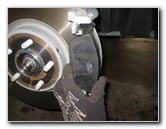 Install New Outer Pad |
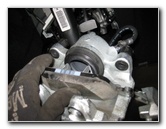 Push In 3 Metal Prongs |
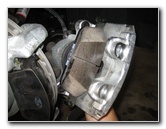 Replace Brake Caliper |
| Install the new
outer brake pad in to the bracket. Push the 3 metal prongs on the back side of the new inner brake pad in to the caliper piston. Carefully lower the caliper back in to the bracket. If the caliper won't fit over the thicker new inner brake pad, you may need to compress the caliper piston back a bit further. |
||
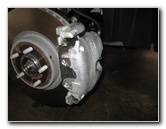 Line Up Bolt Holes |
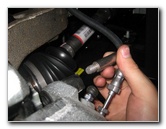 Re-Insert Top Caliper Bolt |
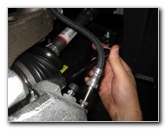 Spin In Counterclockwise |
| Line up the two
bolt holes on the caliper with their corresponding holes in the bracket. Apply a thin layer of brake caliper lubricant grease to the smooth parts of the two caliper bolts / slider pins. Do not apply grease to the threads on the caliper bolt/pins. Push in the two caliper bolts / slider pins. |
||
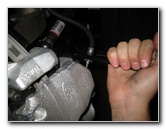 Tighten Top Caliper Bolt |
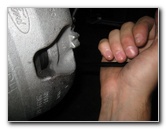 Tighten Bottom Caliper Bolt |
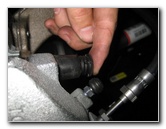 Pop In Bolt Cap |
| Tighten the two
caliper bolts in the counterclockwise direction (as seen from the outside of
the vehicle) to just past hand tight
The service manual specification for tightening the caliper bolts / pins is 21 lb-ft (or 28 Nm) of torque. Double check that the two caliper bolts are tight before moving on to the next steps. Push in the two round black plastic dust caps over the caliper bolt housings. |
||
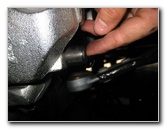 Replace Lower Bolt Cover |
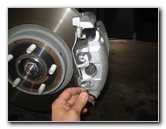 Re-Attach Metal Clip |
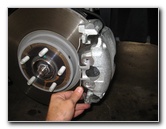 Metal Spring Clip Secure |
| Re-attach the metal
spring clip to the outer edge of the caliper. If your brake pedal previously felt soft or spongy, the brake fluid might be contaminated with water or the brake lines may contain a few air bubbles. It would be best to bleed the brake lines at this time in order to flush out the old fluid and replace it with fresh DOT4 brake fluid. For more on this topic, check out my Brake Line Fluid Bleeding With An Assistant DIY Guide or alternatively the Brake Line Fluid Bleeding With A Power Bleeder Guide. The brake fluid bleeder valve is located underneath a rubber cap on the back side of the caliper next to the upper caliper bolt. |
||
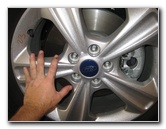 Push On Front Wheel |
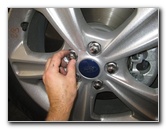 Spin On 5 Lug Nuts |
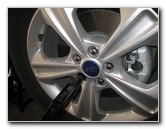 Spin On Clockwise |
| Push the front
wheel back in to place on the lug nut studs. Spin on the five lug nuts in the clockwise direction by hand to make sure that they don't become cross threaded. Continue spinning on the lug nuts with the tire iron in the straightened out position. |
||
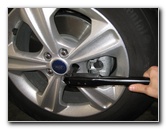 Slightly Tighten Lug Nuts |
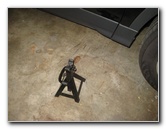 Lower Car From Stands |
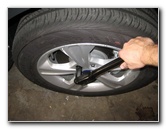 Torque To 100 ft-lbs |
| Slightly tighten
the 5 lug nuts in a star or "criss cross" pattern. Carefully lower the SUV from the jack stands by using the floor jack. Continue tightening the lug nuts in the clockwise direction in a "star" or "criss cross" pattern to about 1/4 to 1/3 turn past hand tight or about 100 lb-ft of torque as specified in the owner's manual. It would be best to use a torque wrench or an impact wrench with a 100 lb-ft torque stick to properly tighten the lug nuts. Sit in the driver's seat of the car and firmly press the brake pedal a few times to restore the brake line pressure. Check the brake fluid in the reservoir and verify that it is at the proper level. If it is low, add some fresh DOT 4 fluid. To break in your new front brake pads, just drive normally for the first few hundred miles while trying to avoid any hard or "panic" stops which may glaze over the new pads and cause them to be noisy and/or not perform as well. It's also a good idea to regularly check your driveway for drops of brake fluid which may indicate a leak, check the brake fluid level in the reservoir, and also verify that the lug bolts are still tight. Be sure to record the brake pad change in your Escape's service records. For more,
check out my other
2013-2016 Ford Escape DIY Repair & Maintenance Guides. |
||
| If you found this guide to be helpful,
please consider making a small donation by clicking on the PayPal.com
"Donate" button located to the right of this paragraph. Thank you!
(Note: I am not a registered charity. Donations are not tax deductible.) |

